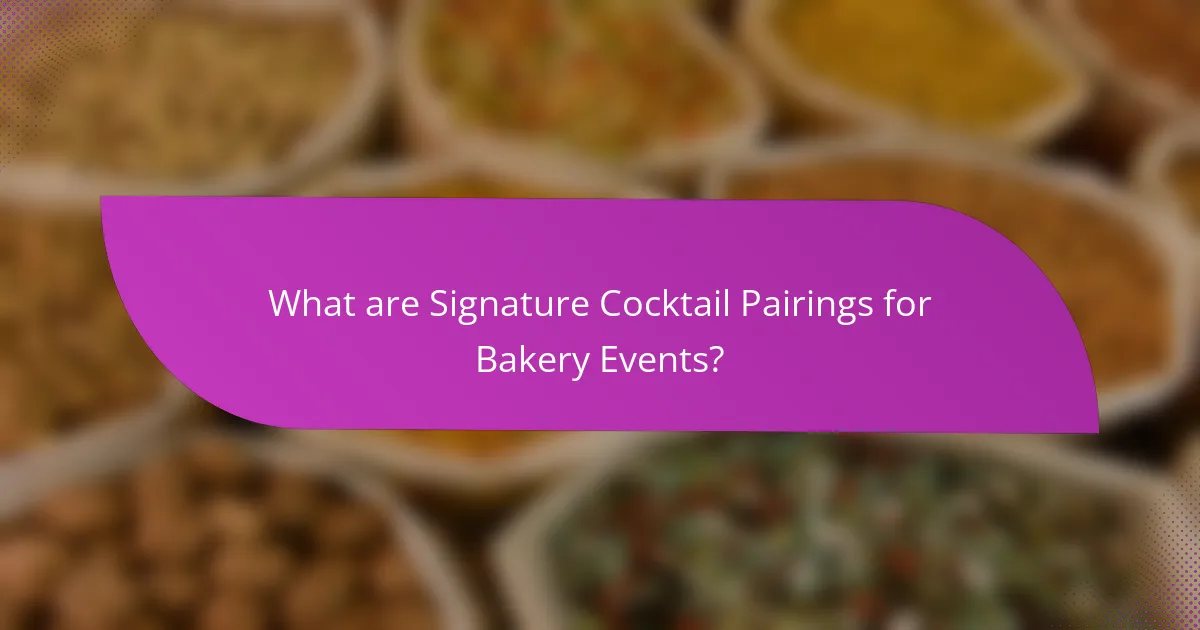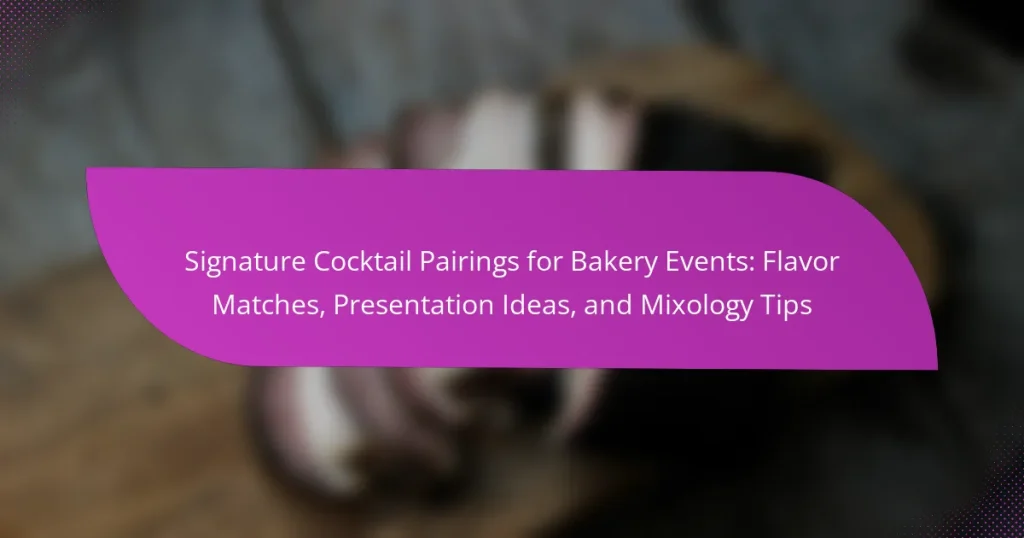Signature cocktail pairings for bakery events play a crucial role in enhancing the overall guest experience. Popular combinations include mimosas with pastries, espresso martinis with chocolate desserts, and berry-infused gin and tonics with fruity baked goods. Additionally, spiced rum cocktails complement pumpkin treats, elevating seasonal flavors. This article explores various flavor matches, presentation ideas, and mixology tips to create harmonious pairings that amplify the taste profiles of baked items, ensuring an enjoyable experience for all attendees.

What are Signature Cocktail Pairings for Bakery Events?
Signature cocktail pairings for bakery events enhance the overall experience. Popular pairings include mimosas with pastries, which complement sweet flavors. Another option is espresso martinis alongside chocolate desserts, creating a rich contrast. For fruity baked goods, consider pairing with a berry-infused gin and tonic. Additionally, pairing a spiced rum cocktail with pumpkin treats can elevate seasonal flavors. Each cocktail choice amplifies the taste profile of the baked items served. These combinations are designed to create harmony between drinks and desserts, enhancing guest enjoyment.
How do signature cocktails enhance bakery events?
Signature cocktails enhance bakery events by providing a unique pairing experience. They complement the flavors of baked goods, creating a harmonious tasting experience. For example, a citrus cocktail can enhance the zest in lemon pastries. This pairing encourages guests to explore new flavor combinations. Additionally, signature cocktails elevate the overall aesthetic of the event. Visually appealing drinks can enhance table presentations and attract attention. They also serve as conversation starters among guests, fostering social interaction. Events featuring signature cocktails often leave a lasting impression on attendees. This memorable experience can increase the likelihood of future attendance at similar events.
What role do flavors play in cocktail and bakery pairings?
Flavors play a crucial role in cocktail and bakery pairings by enhancing the overall tasting experience. Complementary flavors create harmony between the beverage and baked goods. For example, citrus notes in cocktails can brighten rich desserts. Conversely, sweet cocktails can balance savory pastries. The interaction of flavors can elevate both elements, making them more enjoyable. Studies show that well-paired flavors can significantly enhance the perception of taste. This pairing approach encourages creativity in both mixology and baking, leading to unique combinations.
Why is presentation important for cocktail pairings at bakery events?
Presentation is important for cocktail pairings at bakery events because it enhances the overall experience. Visual appeal attracts attendees and encourages them to try the cocktails. A well-presented cocktail can complement the aesthetics of baked goods. This synergy between drinks and desserts elevates the event’s ambiance. Studies show that first impressions are influenced by presentation. In culinary contexts, appealing visuals can increase perceived taste quality. Therefore, thoughtful presentation plays a crucial role in engaging guests at bakery events.
What types of bakery items pair well with cocktails?
Savory pastries, such as cheese scones and herb biscuits, pair well with cocktails. They complement the flavors of various drinks. Sweet items like fruit tarts and chocolate brownies also work well. These desserts enhance the sweetness of cocktails. Mini quiches and spanakopita provide a delightful contrast to fruity beverages. They add a savory element that balances the sweetness. Additionally, light cookies, such as lemon or almond, can refresh the palate. Their subtle flavors harmonize with many cocktails.
How do flavors in pastries influence cocktail choices?
Flavors in pastries significantly influence cocktail choices by guiding the selection of complementary or contrasting tastes. For instance, fruity pastries pair well with light, citrus-based cocktails. Chocolate pastries often match with rich, dark spirits like whiskey or rum. Spiced pastries can enhance cocktails featuring similar spice notes, such as cinnamon or nutmeg. The sweetness level of the pastry also dictates cocktail sweetness, ensuring a balanced flavor profile. Studies show that flavor compatibility enhances the overall tasting experience at events. This alignment creates a harmonious pairing that elevates both the pastry and the cocktail.
What are some classic bakery and cocktail combinations?
Classic bakery and cocktail combinations include several well-known pairings. For example, chocolate cake pairs well with a rich red wine or a chocolate martini. Lemon meringue pie is often complemented by a refreshing gin and tonic. Croissants can be enjoyed with a mimosa, enhancing their buttery flavor. Cheesecake goes nicely with a fruity berry cocktail, balancing its creaminess. Finally, carrot cake is often paired with a spiced rum cocktail, which matches its warm spices. These combinations enhance the overall tasting experience, creating a harmonious blend of flavors.
What are the key attributes of successful cocktail pairings?
Successful cocktail pairings are defined by complementary flavors, balance, and presentation. Complementary flavors enhance the overall taste experience. For example, citrus cocktails pair well with rich desserts. Balance refers to the harmony between sweetness, acidity, and bitterness. A well-balanced cocktail offsets the sweetness of baked goods. Presentation plays a crucial role in the appeal of cocktail pairings. A visually appealing drink enhances the dining experience. Seasonal ingredients also contribute to successful pairings. Utilizing fresh, in-season produce adds vibrancy and relevance. Lastly, understanding the audience’s preferences ensures the cocktails resonate with guests.
How do sweetness and acidity affect pairing decisions?
Sweetness and acidity significantly influence pairing decisions in mixology. Sweetness can enhance flavors and balance out acidity. For instance, a sweet cocktail can complement a tart pastry. Conversely, acidity can cut through richness and provide a refreshing contrast. A citrusy cocktail pairs well with creamy desserts. The balance between these two elements can elevate the overall tasting experience. Studies show that well-balanced pairings improve palate satisfaction.
What unique ingredients can elevate cocktail pairings?
Unique ingredients that can elevate cocktail pairings include exotic fruits, herbs, and spices. Exotic fruits like passion fruit and lychee add vibrant flavors. Fresh herbs such as basil and mint provide aromatic complexity. Spices like cardamom and smoked paprika introduce unexpected depth. Unique bitters, such as chocolate or lavender, can enhance the overall profile. Specialty syrups, like rosemary-infused or elderflower, offer a distinct sweetness. These ingredients create memorable taste experiences that complement baked goods. Their use in cocktails aligns with current mixology trends focused on innovative flavors.
How can I transition from general pairings to specific examples?
To transition from general pairings to specific examples, start by identifying broad categories of flavors. For instance, consider common flavor profiles like citrus, chocolate, or berry. Next, match these profiles with specific cocktails that embody these flavors. For example, a citrus profile can lead to cocktails like a Lemon Drop or a Mojito. Provide detailed descriptions of how each cocktail complements specific baked goods. For instance, a Lemon Drop pairs well with lemon bars due to its tartness. This method allows for a clear connection between general pairings and concrete examples. By systematically narrowing down from broad categories to specific cocktails, you create a logical flow that enhances understanding.
What are some creative presentation ideas for cocktails at bakery events?
Serve cocktails in mini pastry cups for a unique and edible presentation. Use clear glassware to showcase vibrant colors of the cocktails. Garnish with bakery-inspired elements, like cookie crumbles or fruit slices. Create cocktail towers with stacked glasses for visual impact. Incorporate themed decorations, such as edible flowers or sprinkles that match the bakery’s aesthetic. Offer cocktail flights with small samples for variety and engagement. Use creative ice molds shaped like baked goods to enhance visual appeal. Present cocktails alongside matching desserts for a cohesive experience.
What are the best mixology tips for cocktail pairings?
The best mixology tips for cocktail pairings include understanding flavor profiles and balancing ingredients. Pair cocktails with complementary flavors found in baked goods. For example, citrus cocktails pair well with fruity pastries. Herbal cocktails can enhance the flavors of nut-based desserts. Consider the sweetness level of both the cocktail and dessert for harmony. Use fresh ingredients to elevate the overall taste experience. Garnishes should reflect the dessert’s flavors for visual appeal. Experiment with different spirits to find unique combinations. Successful pairings enhance the enjoyment of both the cocktail and the food.
How can I craft cocktails that complement bakery flavors?
To craft cocktails that complement bakery flavors, focus on matching the flavor profiles of both. Use ingredients that enhance the bakery items, such as fruits, spices, or herbs. For example, pair citrus cocktails with lemon tarts or berry cocktails with mixed berry pastries. Incorporate similar flavors found in the baked goods into the cocktails. Use complementary sweeteners, like honey or vanilla syrup, to bridge flavors. Consider the texture of the baked goods when selecting cocktail styles. Creamy cocktails can pair well with rich desserts. Balance sweetness in the cocktails to match the sweetness of the bakery items. This approach ensures a harmonious tasting experience.
What techniques can enhance the visual appeal of cocktails?
Using garnishes can significantly enhance the visual appeal of cocktails. Fresh herbs, citrus slices, or edible flowers add vibrant colors and textures. Layering ingredients creates a visually striking effect. For example, using a clear glass allows for a gradient of colors to be seen. Rimming glasses with sugar or salt adds an attractive finishing touch. Utilizing unique glassware can also elevate presentation. Techniques like smoke infusion can create dramatic visuals as well. Lastly, incorporating colorful ice cubes or spheres can add a playful element to the drink.
What are common mistakes to avoid when pairing cocktails with bakery items?
Common mistakes to avoid when pairing cocktails with bakery items include ignoring flavor profiles. Bakery items often have sweet, rich, or savory elements. Cocktails should complement these flavors rather than clash with them. Another mistake is selecting cocktails with overpowering alcohol content. High-proof spirits can overwhelm delicate bakery flavors. Additionally, failing to consider texture can lead to poor pairings. For example, pairing a heavy cocktail with a light pastry may create an unbalanced experience. It’s also important to avoid mismatched sweetness levels. A very sweet dessert may not pair well with a bitter cocktail. Lastly, neglecting the seasonality of ingredients can result in less enjoyable pairings. Using fresh, seasonal ingredients enhances both cocktails and bakery items.
Signature cocktail pairings for bakery events enhance the guest experience by creating harmonious flavor matches between beverages and baked goods. This article explores various pairing options, such as mimosas with pastries and espresso martinis with chocolate desserts, while emphasizing the importance of flavor compatibility, balance, and presentation. It also discusses the role of sweetness and acidity in pairing decisions, creative presentation ideas, and common mistakes to avoid. Additionally, readers will find mixology tips for crafting cocktails that complement bakery flavors, ensuring a memorable experience for attendees.




